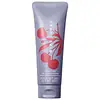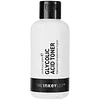What's inside
What's inside
 Key Ingredients
Key Ingredients

 Benefits
Benefits

 Concerns
Concerns

 Ingredients Side-by-side
Ingredients Side-by-side

Pyrus Malus Pulp Extract
Skin ConditioningGlycolic Acid
BufferingGlyceryl Stearate Se
EmulsifyingCetearyl Alcohol
EmollientSodium Cocoyl Isethionate
CleansingCaprylic/Capric Triglyceride
MaskingLactic Acid
BufferingPalmitic Acid
EmollientStearic Acid
CleansingCeteareth-20
CleansingButyrospermum Parkii Butter
Skin ConditioningPrunus Avium Seed Oil
EmollientMalpighia Punicifolia Fruit Extract
AntioxidantBromelain
Skin ConditioningPapain
Skin ConditioningLactobacillus/Punica Granatum Fruit Ferment Extract
Skin ConditioningPrunus Cerasus Shell Powder
AbrasiveLitchi Chinensis Seed Powder
AbrasiveFurcellaria Lumbricalis Extract
Skin ConditioningTocopherol
AntioxidantCoconut Acid
CleansingHelianthus Annuus Extract
EmollientRaphanus Sativus Root Extract
AstringentRosmarinus Officinalis Leaf Extract
AntimicrobialOryza Sativa Bran Extract
Skin ConditioningLeuconostoc/Radish Root Ferment Filtrate
AntimicrobialCaprylyl Glycol
EmollientMaltodextrin
AbsorbentPentaerythrityl Tetra-Di-T-Butyl Hydroxyhydrocinnamate
AntioxidantSodium Benzotriazolyl Butylphenol Sulfonate
UV AbsorberSodium Isethionate
CleansingSodium Hydroxide
BufferingPhenoxyethanol
PreservativeParfum
MaskingCI 16035
Cosmetic ColorantCI 19140
Cosmetic ColorantCI 17200
Cosmetic ColorantPyrus Malus Pulp Extract, Glycolic Acid, Glyceryl Stearate Se, Cetearyl Alcohol, Sodium Cocoyl Isethionate, Caprylic/Capric Triglyceride, Lactic Acid, Palmitic Acid, Stearic Acid, Ceteareth-20, Butyrospermum Parkii Butter, Prunus Avium Seed Oil, Malpighia Punicifolia Fruit Extract, Bromelain, Papain, Lactobacillus/Punica Granatum Fruit Ferment Extract, Prunus Cerasus Shell Powder, Litchi Chinensis Seed Powder, Furcellaria Lumbricalis Extract, Tocopherol, Coconut Acid, Helianthus Annuus Extract, Raphanus Sativus Root Extract, Rosmarinus Officinalis Leaf Extract, Oryza Sativa Bran Extract, Leuconostoc/Radish Root Ferment Filtrate, Caprylyl Glycol, Maltodextrin, Pentaerythrityl Tetra-Di-T-Butyl Hydroxyhydrocinnamate, Sodium Benzotriazolyl Butylphenol Sulfonate, Sodium Isethionate, Sodium Hydroxide, Phenoxyethanol, Parfum, CI 16035, CI 19140, CI 17200
 Reviews
Reviews

Ingredients Explained
These ingredients are found in both products.
Ingredients higher up in an ingredient list are typically present in a larger amount.
Glycolic Acid is arguably the most famous alpha hydroxy acid (AHA) with tons of research backing its benefits.
It is found naturally in sugar cane but the form used in skincare is usually synthetic for purity and stability.
Glycolic acid removes the top layer of dead skin cells to allow newer and fresher ones to emerge.
AHAs work by breaking down the structural “glue” that holds old skin cells in place. When that buildup is gone, your skin can renew itself more efficiently.
Research also shows glycolic acid stimulates collagen production, helping to firm and thicken the skin over time. This is one of its biggest advantages over other AHAs.
Overall, glycolic acid helps with:
Fun fact: Glycolic acid boosts skin hydration by helping it produce molecules that increase hyaluronic acid naturally.
To work best, glycolic acid products should have a pH between 3-4 (that’s where exfoliation is most effective but still gentle on skin).
The pH and concentration of a product are key to its effectiveness:
It is normal to feel a slight stinging sensation when using glycolic acid. This usually fades as your skin adjusts.
Because glycolic acid has the smallest molecular size in the AHA family, it can penetrate deeper, which enhances its effectiveness but also makes it more likely to irritate sensitive skin.
If your skin is very sensitive or prone to rosacea, glycolic acid may be too strong; in that case, try milder options like lactic acid or a PHA instead.
Recent studies suggest glycolic acid might even help protect against UV damage. But don’t skip sunscreen! Freshly exfoliated skin is more sensitive to the sun.
Glycolic acid is a skincare superstar. It smooths, brightens, hydrates, and firms the skin. Unless you’re highly sensitive, it’s well worth adding to your routine.
Read more about some other popular AHA's here:
Learn more about Glycolic AcidPhenoxyethanol is a preservative that has germicide, antimicrobial, and aromatic properties. Studies show that phenoxyethanol can prevent microbial growth. By itself, it has a scent that is similar to that of a rose.
It's often used in formulations along with Caprylyl Glycol to preserve the shelf life of products.
Sodium Hydroxide is also known as lye or caustic soda. It is used to adjust the pH of products; many ingredients require a specific pH to be effective.
In small amounts, sodium hydroxide is considered safe to use. However, large amounts may cause chemical burns due to its high alkaline.
Your skin has a natural pH and acid mantle. This acid mantle helps prevent harmful bacteria from breaking through. The acid mantle also helps keep your skin hydrated.
"Alkaline" refers to a high pH level. A low pH level would be considered acidic.
Learn more about Sodium Hydroxide